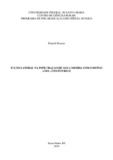| dc.creator | Boeno, Daniel | |
| dc.date.accessioned | 2019-10-21T14:33:42Z | |
| dc.date.available | 2019-10-21T14:33:42Z | |
| dc.date.issued | 2019-02-26 | |
| dc.identifier.uri | http://repositorio.ufsm.br/handle/1/18632 | |
| dc.description.abstract | The basic infiltration rate (TIB) is important in the definition of the irrigation rate and in the planning of soil conservation
systems. The TIB’s estimate has often been made with a double concentric ring, due to its easy usage and low cost.
However, there is evidence that the rate of stable infiltration measured by the double concentric ring (TIEAC) is greater
than that determined by other methods and it overestimates the TIB. The hydraulic load present on the soil surface and
the absence of formation or increase of the surface sealing are particularities of the method that favor the overestimation
of the TIB. However, a gap that has not been explored yet is whether the lateral flow inside the profile, especially in
heterogeneous soil profiles, may be a major cause of the overestimation of TIB by TIEAC. A way of detecting the existence
of lateral flow is to verify if there are differences in measured TIEAC at different depths. Using this strategy, the objective
of this study was to investigate if there is any disagreement between TIEAC and the saturated flow measured at different
depths of the soil profile. TIEAC measurements were made at the top of horizons A, E and Bt (pedogenetic factor), in an
experimental area with compacted, scarified soil conditions, and absence of both (anthropic factor). There was no effect
of soil conditions in the TIEAC, probably because the measurements occurred 7 months after the establishment of the
conditions. It was possible to detect the pedogenetic interference in the TIEAC, because the TIEAC of the horizon A was
10 times greater than the Bt, which is considered the most restrictive. The decrease of the TIEAC in depth indicates that
the TIEAC measured at the soil surface is an overestimation of the TIB. | eng |
| dc.description.sponsorship | Coordenação de Aperfeiçoamento de Pessoal de Nível Superior - CAPES | por |
| dc.language | por | por |
| dc.publisher | Universidade Federal de Santa Maria | por |
| dc.rights | Attribution-NonCommercial-NoDerivatives 4.0 International | * |
| dc.rights.uri | http://creativecommons.org/licenses/by-nc-nd/4.0/ | * |
| dc.subject | Camada restritiva | por |
| dc.subject | Superestimativa | por |
| dc.subject | Lateralização de fluxo | por |
| dc.subject | Restrictive layer | eng |
| dc.subject | Overestimate | eng |
| dc.subject | Flow lateralization | eng |
| dc.title | Fluxo lateral na infiltração de água medida com duplo anel concêntrico | por |
| dc.title.alternative | Lateral flow in the water infiltration measured with the double ring infiltrometer | eng |
| dc.type | Dissertação | por |
| dc.description.resumo | A taxa de infiltração básica de água no solo (TIB) é importante na definição da taxa de irrigação e no planejamento de
sistemas de conservação do solo. A estimativa da TIB tem sido feita frequentemente com duplo anel concêntrico, devido
à facilidade de utilização e o baixo custo. Contudo, existem evidências de que a taxa de infiltração estável medida com o
duplo anel concêntrico (TIEAC) é maior do que a determinada por outros métodos e superestima a TIB. A carga hidráulica
presente na superfície do solo e a ausência de formação ou de incremento do selamento superficial são particularidades
do método que favorecem a superestimativa da TIB. Porém, uma lacuna ainda não explorada é se o fluxo lateral no
interior do perfil, principalmente em perfis de solo heterogêneos, pode ser um grande causador da superestimativa da TIB
pela TIEAC. Uma maneira de detectar a existência de fluxo lateral é verificar se existem diferenças de TIEAC medida em
diferentes profundidades. Usando esta estratégia, o objetivo deste estudo foi investigar se existe discordância entre TIEAC
e o fluxo saturado medido em diferentes profundidades do perfil de solo. Medições de TIEAC foram feitas no topo dos
horizontes A, E e Bt (fator pedogenético), em uma área experimental com condições de solo compactado, escarificado, e
ausência de ambos (fator antrópico). Não houve efeito das condições de solo na TIEAC, provavelmente porque as medições
ocorreram 7 meses após o estabelecimento das condições. Foi possível detectar a interferência pedogenética na TIEAC,
pois a TIEAC do horizonte A foi 10 vezes maior do que a do Bt, este considerado o mais restritivo. O decréscimo da TIEAC
em profundidade indica que a TIEAC medida na superfície do solo é uma superestimativa da TIB. | por |
| dc.contributor.advisor1 | Gubiani, Paulo Ivonir | |
| dc.contributor.advisor1Lattes | http://lattes.cnpq.br/7251203817503318 | por |
| dc.contributor.referee1 | Reinert, Dalvan José | |
| dc.contributor.referee1Lattes | http://lattes.cnpq.br/0341150684713995 | por |
| dc.contributor.referee2 | Drescher, Marta Sandra | |
| dc.contributor.referee2Lattes | http://lattes.cnpq.br/9433167815651296 | por |
| dc.creator.Lattes | http://lattes.cnpq.br/7291751385111230 | por |
| dc.publisher.country | Brasil | por |
| dc.publisher.department | Agronomia | por |
| dc.publisher.initials | UFSM | por |
| dc.publisher.program | Programa de Pós-Graduação em Ciência do Solo | por |
| dc.subject.cnpq | CNPQ::CIENCIAS AGRARIAS::AGRONOMIA | por |
| dc.publisher.unidade | Centro de Ciências Rurais | por |



